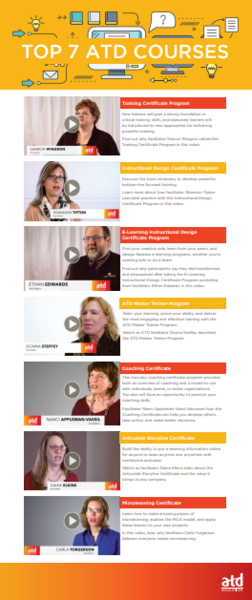ATD Blog
Learn Anything Good Lately?
Thu Nov 29 2018

Lots of ATD members and other talent development professionals have. Read on . . .

Confused about how to begin developing an e-learning course? Heard the buzz around microlearning, but not really sure as to when and how? Understand some of the benefits of coaching but would prefer to practice coaching skills in a safe environment?
Now’s a great time to take a fresh look at the learning that’s available from ATD Education. To help you get started, we wanted to share some of the top training courses that your talent development colleagues have taken advantage of this year.
Training Certificate
Participant Claire Scott had this to say about the Training Certificate program: "My favorite takeaways were watching Peggy \[Hutcheson, facilitator\] effortlessly move the class from one activity to the other, injecting fun into training and the tiny details that Peggy went into to get us thinking about every aspect of facilitation. I would definitely love to attend another program." This meaty program provides the basics of adult learning theory, a foundation of conducting a needs assessment, tips for applying effective training techniques, and more.
Instructional Design Certificate
You will walk away with not only the learning program you design for your organization so that you can immediately apply it, but also confidence in your knowledge and skill set, says facilitator Shannon Tipton of the Instructional Design Certificate. In her blog explaining that she is a learning design geek, Tipton describes that learning design is about touching the hearts and minds of people, that the design process creates connectivity and builds collaboration, and that learning design helps you find out more about your business and its people. How cool is that?!
**
ATD Master Trainer Program
**The importance of a good, clear learning objective cannot be overstated. The objective must be measurable and tied to the business need, with the training program wrapped around that objective, advises facilitator Donna Steffey. The ATD Master Trainer Program validates that a training professional has “mastered” her profession. Steffey notes that participants walk away from the program feeling as if facilitator and participants learned together.
**
Coaching Certificate
**Coaching today is a widespread tool used to develop employees, often in a low-cost, flexible fashion. Because of its extensive use, coaching is a skill set in high demand. The two-day Coaching Certificate program provides both an overview of coaching and a model to use with individuals, teams, or entire organizations. Participants also will have an opportunity to practice their coaching skills. As participant Beverly Fuentes stated, “I have been a professional coach for over 30 years. I needed a refresher, am a member of ATD, and found my organization would pay for my attendance, as this training was in-state.”
**[
Articulate Storyline Certificate
](https://www.td.org/education-courses/articulate-storyline-certificate)**There are a number of reasons why organizations are going the e-learning route, states Diane Elkins, one of the facilitators of the Articulate Storyline Certificate course. Reasons include the sheer number of learners, a far-flung workforce, or a matter of immediacy—for example, employees starting every week and it not being feasible to have an instructor-led onboarding program taught that frequently. The course is designed to mirror participants’ work situations so that attendees get the full experience of work flow and are able to create their own e-learning course.
**
Microlearning Certificate
**When you provide microlearning to your organization’s learners, explains Carla Torgerson, you demonstrate that you understand what learners need and that you’re listening to both learners and your organization. You’re giving employees the information they need quickly so they can return to their jobs quickly. What are some ways to use microlearning, those short bursts of learning that employees can access anytime, anywhere? A few of the ways include following up on other training, as performance support, or even as stand-alone training. Participants in the Microlearning Certificate course learn how to create good pieces of microlearning and create an entire learning program.
